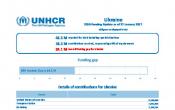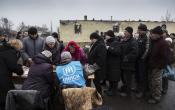Ukraine
For information on UNHCR’s operations in Ukraine prior to 2016, please visit the Regional Office in Ukraine page.
Operation: Ukraine
Location
{"longitude":31,"latitude":49,"zoom_level":5}
Latest update of camps and office locations 21 Nov 2016. By clicking on the icons on the map, additional information is displayed.
Key Figures
| 2016 end-year results | |
| 64,300 | IDP households (139,100 individuals) received core relief and/or winterization items |
| 49,500 | IDPs and 3,900 refugees and asylum-seekers were supported with legal aid |
| 8,700 | IDP households received shelter support to repair their houses |
| 5,100 | IDPs and 426 refugees and asylum-seekers received cash assistance |
| 20 | refugees had their naturalization facilitated, while 23 people with undetermined nationality were assisted with confirmation of nationality |
| 2017 Planning Figures | |
| 50,000 | IDPs will receive return packages |
| 37,645 | IDPs will receive cash grants or vouchers for business start-up |
| 3,200 | IDPs will receive long-term/permanent shelter and an additional 6,600 IDPs will receive shelter support |
| 100% | of unaccompanied and separated children will have a best interest process initiated or completed |
| 80% | of refugees and asylum-seekers will have access to national/government primary health care facilities |
| 80% | of the estimated stateless population will be identified as stateless |
Latest Updates and Related Links
People of Concern
| 2016 | 1,845,246 |

[["Refugees",3302],["Asylum-seekers",6573],["IDPs",1800000],["Returned refugees",8],["Stateless",35363]]
Loading ...
Ukraine
< Back
2016
{"categories":[2012,2013,2014,2015,2016,2017],"budget":[null,null,null,null,42.25391395,37.65301174],"expenditure":[null,null,null,null,24.60120571,null]}
{"categories":[2012,2013,2014,2015,2016,2017],"p1":[null,null,null,null,7.1968692,6.7573527],"p2":[null,null,null,null,0.66575082,0.66464143],"p3":[null,null,null,null,null,null],"p4":[null,null,null,null,34.39129393,30.23101761]}
{"categories":[2012,2013,2014,2015,2016,2017],"p1":[null,null,null,null,5.4217403,null],"p2":[null,null,null,null,0.0711454,null],"p3":[null,null,null,null,null,null],"p4":[null,null,null,null,19.10832001,null]}
Loading ...
CHOOSE A YEAR
- 2016
- 2017
Working environment
Frequent violations of the ceasefire in eastern Ukraine through 2016 caused casualties and damage to infrastructure and properties along the contact line. Increased insecurity also hampered humanitarian access, particularly in non-government controlled areas (NGCA). Despite the danger, some 800,000 people live within twenty kilometres on both sides of the line of contact. Some returns to these areas were witnessed, mainly by people who did not have sufficient resources to continue living in other areas of Ukraine.UNHCR, as part of the inter-agency response and in line with the 2016 Humanitarian Response Plan (HRP), focused on three main objectives: i) advocate for and respond to the protection needs of conflict-affected people with due regard to international norms and standards; ii) provide emergency assistance and ensure nondiscriminatory access to quality essential services for populations in need; and iii) improve the resilience of conflict-affected people, prevent further degradation of the humanitarian situation and promote recovery and social cohesion.
UNHCR led the protection cluster and co-led the shelter/NFI cluster. The protection cluster response included: i) responding to the protection needs of IDPs and conflict-affected people; ii) at community centres, collecting, analysing and reporting on critical information related to people in need, and identification of vulnerable individuals for targeted assistance; and iii) advocating with national actors, duty bearers and international stakeholders to respect and promote protection standards and ensure accountability for rights violations.
The shelter/NFI cluster focused on strengthening coordination; addressing the most immediate shelter and NFI needs of the most vulnerable individuals; setting minimal standards for humanitarian response; and piloting long-term shelter solutions.
UNHCR advocacy was prioritized around issues related to freedom of movement across the contact line; humanitarian needs, including protection, of people living along the contact line and in NGCAs; as well as the IDP law, which has been improved through various amendments.
Population trends
- The Government has registered more than 1.6 million IDPs. The UN and humanitarian response partners use a planning figure of 0.8 to 1 million IDPs. Within NGCAs, in 2016 an estimated 200,000 returned home from either within Ukraine or abroad.
- More than 1.2 million Ukrainians have sought asylum or other forms of legal stay in neighbouring countries since the beginning of the crisis.
- As of the end of 2016, Ukraine hosted 3,302 refugees and 2,824 asylum-seekers. The majority originate from Afghanistan and Syria, while some 70 other countries of origin are also represented.
- More than 35,000 people were estimated to be stateless.
Achievements and impact
- Advocacy was a central component of UNHCR’s response to internal displacement in Ukraine, with efforts focused on freedom of movement across the contact line; access to pensions and social benefits; voting rights of IDPs; registration; and housing, land and property issues.
- The Government of Ukraine has taken several measures relating to protection and solutions for IDPs. A legal framework and national plan for IDP reintegration was adopted in 2016, and a Ministry for the Temporary Occupied Territories and IDPs was established to coordinate the IDP response. UNHCR supported the Ministry on legislative development, strategic communications (including with IDPs themselves), and capacity building. By the end of 2016, the Ministry had established five thematic working groups dedicated to aligning Ukrainian legislation on IDPs with international standards.
- UNHCR supported 70 community initiatives in close to 40 communities. Activities proposed by the IDP communities themselves ranged from training the media, rehabilitation equipment for hospice for internally displaced elderly with disabilities; education and extra-curricular activities for children; preservation of cultures; awareness-raising campaigns on sexual and gender-based violence (SGBV) and development of response mechanisms.
- UNHCR worked with communities to implement 34 quick impact projects to foster peaceful co-existence. Initiatives included the creation of community centres with free legal aid offices; the creation of a trauma hospital for children; the rehabilitation of a residential centre for displaced children with specific needs; and other projects to reduce the strain on local infrastructure, among others.
- In 2016, some amendments to the Refugee Law to strengthen registration and the asylum process were adopted. In the area of reducing risks of statelessness, amendments to the Civil Procedural Code of Ukraine allowed immediate processing of a claim to establish births in NGCA by any court in the Government-controlled areas (GCA).
Unmet needs
- Access to NGCAs remained restricted and constrained the timely transportation of assistance.
- Restrictions imposed on movements through check points between GCAs and NGCAs represented a challenge to freedom of movement. The waiting time to cross was long and facilities at the checkpoints remained inadequate. Despite these barriers, in 2016, checkpoints along the line of contact reported 8.5 million crossings in both directions. Among some other initiatives to improve the situation, UNHCR and partners established legal assistance in some checkpoints to better inform IDPs of their rights and checkpoint requirements.
- UNHCR continued to advocate the creation of compensation mechanisms to resolve housing, land and property issues to support returns. IDPs continued to face challenges in exercising their rights to social benefits.
- Local integration is challenging for refugees and asylum-seekers. In spite of UNHCR’s advocacy, legislative barriers remained and prevented people of concern from accessing the formal labour market.
The situation in Ukraine remains unpredictable due to ongoing conflict in the east and a struggling economy, and could deteriorate rapidly.
In 2016, UNHCR will continue to address the needs of internally displaced people (IDPs) and affected communities in Ukraine. By November 2015, the Government had registered around 1,5 million IDPs. According to the Ministry of Social Policy (MoSP) of Ukraine the total number of internally displaced persons has reached 1.5 million[1].
Analysis and crosschecking of data on the basis of multiple government datasets indicate that the likely figure of IDPs located in government controlled areas (GCA) is approximately 800,000. The majority of the 4.3 million people affected by the insecurity are living in non-government controlled areas or in regions bordering conflict-affected areas, such as the Government-controlled areas of Donetsk, Luhansk, Dnipropetrovsk, Kharkiv, and Zaporizhia provinces.
UNHCR interventions will target affected communities in non-government controlled areas, affected communities along the contact line, and areas with a high concentration of IDPs. More emphasis on stabilization and a solutions-oriented approach will be adopted, including activities to promote integration and institutional capacity-building. The Government of Ukraine bears the primary responsibility for the protection of displaced citizens, in accordance with national legislation. UNHCR continues to advocate for the adoption of the regulatory framework to implement important provisions of the national IDP law, including those relating to housing, socio-economic rights and property rights. UNHCR and partners will continue to advocate for freedom of movement, housing rights, and access to legal assistance for IDPs, and humanitarian access to IDPs.
The Office will continue working with partners in non-government-controlled areas and along the contact line to provide shelter and relief items. In light of the increase in refugee flows to Europe, UNHCR will pursue its refugee protection and asylum-related interventions in 2016, including by building the capacity of partners and border monitoring.
[1] This figure has come under discussion in late 2015.




